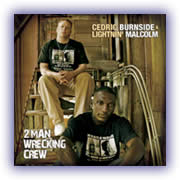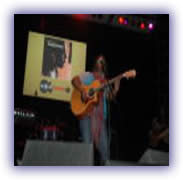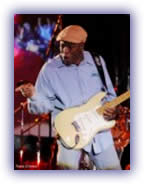On Friday night we started out at
the Flat Branch Park stage to take in Cedric Burnside
& Lightnin’ Malcolm.
 Being
the grandson of R.L. Burnside did not cut Cedric
Burnside any extra slack. He had to earn his place
behind the drum kit just like anybody else. Growing
up in the hills of Marshall County Mississippi,
it was not uncommon to find twelve year old Cedric
banging the hell out of the set at Junior Kimbrough’s
juke joint until three a.m., only to get up for
school three hours later. By the age of sixteen
Cedric had well earned his position with R.L. and
Kenny Brown and abandoned his school work to hit
the road.
Being
the grandson of R.L. Burnside did not cut Cedric
Burnside any extra slack. He had to earn his place
behind the drum kit just like anybody else. Growing
up in the hills of Marshall County Mississippi,
it was not uncommon to find twelve year old Cedric
banging the hell out of the set at Junior Kimbrough’s
juke joint until three a.m., only to get up for
school three hours later. By the age of sixteen
Cedric had well earned his position with R.L. and
Kenny Brown and abandoned his school work to hit
the road.
At age 30, singer, guitarist, songwriter,
and wild live performer Steve “Lightnin”
Malcolm has over 16 years stage experience. Born
in rural Missouri, Malcolm enjoyed the freedom of
country life, quickly learning to entertain himself
and others around him. Growing up in a little village
called Burgess MO. in a country house next to the
KCS Railroad that ran from Kansas City to New Orleans,
the train has always been a theme in Malcolm’s
music, as well as the inspiration for the steady,
insistent bass rhythms of rural dance music.
This juke joint duo, which is the
name of one of their recent albums, define the north
Mississippi hills blues sound with their steady
hard driving rhythms. They played a mixture of original
songs mostly written by Cedric, a collection of
R.L.’s songs and a few from the Junior Kimbrough
songbook. Some of the most memorable were when Cedric
sang his grandfather’s classics of Going Down
South and When My First Wife Left Me. Lightnin’
did a soulful rendition of Jr. Kimbrough’s,
Leave Her Alone, with a killer guitar riff, which
he used throughout the set, sometimes playing an
octave lower and others with a wah pedal. After
the set, they were humble enough to spend time with
their fans chatting and autographing CD’s.
Jake and I decided this CD was a must for our collection.
Next we made our way to the Peace
Park stage to check out Ruthie Foster.
 Ruthie
is from Austin, Texas and has a deep background
of old soul and blues and even some R&B. Early
on, long before she got into the folk thing, she
was doing more soul on acoustic guitar than anything
else. Since returning to her native Texas in the
mid-’90s after a period that found her touring
with the U.S. Navy band Pride and even spending
a few years in New York City under contract to Atlantic
Records, Foster quickly established herself as one
of the acoustic music world’s brightest stars
from the Kerrville Folk Festival to Austin City
Limits to stages all across North America and Europe.
Ruthie
is from Austin, Texas and has a deep background
of old soul and blues and even some R&B. Early
on, long before she got into the folk thing, she
was doing more soul on acoustic guitar than anything
else. Since returning to her native Texas in the
mid-’90s after a period that found her touring
with the U.S. Navy band Pride and even spending
a few years in New York City under contract to Atlantic
Records, Foster quickly established herself as one
of the acoustic music world’s brightest stars
from the Kerrville Folk Festival to Austin City
Limits to stages all across North America and Europe.
This was my first exposure to Ruthie’s
music, but will certainly not be my last! Ruthie
was a tremendous vocalist and sang a mixture of
blues, gospel, folk and reggae while strumming her
six string acoustic. She described her approach
to music as a little bit of Otis Redding and Sam
Cooke with a little Ruthie in the middle. Sitting
at the keyboards, she belted out Phenomal Woman,
a cut from her latest album Phenomal, getting the
crowd pumped up. On the softer side, she did Mississippi
John Hurt’s, Praying on the Old Campgrounds,
with the drummer using spoons as percussion with
an incredible solo. Ruthie kept asking the crowd
if it was ok to mix her blues with gospel, to which
she certainly did while telling stories of her childhood
church days with Aunt Cora in the choir while incorporating
Browine McGee’s Walk On that left you with
goose bumps and muttering Amen.
On Saturday, the next morning the
festival started at 11 and Jake and I made our way
back to the stage in Peace Park to check out Harper.
Harper, from Australia is an artist
who blurs the lines between rock, blues, soul and
world music. His harp performances, distinctive
instrumentation, and the unhurried story telling
of his songs occupy a category of its own. He is
a musical visionary who is unafraid to mix the didgeridoo,
a wind instrument native to Australian Aborigines
culture of his homeland, along with modern percussive
rhythms.
Harper’s voice is one of his
best instruments, a solid vocalist who can make
it deep and gravely while remaining harmonious,
throwing in a little Jazzy scat as evidenced in
his rendition of A Last Cup of Coffee. In his bag
of tricks, he sang through his Shure Green Bullet
harp mic, giving his stanzas a distortive tunnel
effect. His harp playing and rock oriented stuff
was Blues Travelersque.
As far as the band, the drums were
mixed too loud and the bass player was overpowering,
taking away from the performance. However, when
he incorporated the didgeridoo which had a deep
throaty tribal resonance, it vibrated through your
entire body.
Once Harper finished his set, we
headed for the main stage downtown, sponsored by
Shelter Insurance. Next up on the bill was Tab Benoit.
Guitarist, singer, and songwriter
Tab Benoit makes his home near New Orleans in Houma,
LA. Born November 17, 1967, he's one of a handful
of bright rising stars on the modern blues scene.
For most of the 1990s, he's been working each of
his records the old fashioned way, by playing anywhere
and everywhere him and his band can play. Since
the release of his first album, For Justice, Benoit
has taken his brand of Cajun-influenced blues all
over the U.S., Canada, and Europe. Nice and Warm,
his debut album for Houston-based Justice Records,
prompted some critics to say he's reminiscent, at
times, of three blues guitar gods: Albert King,
Albert Collins, and Jimi Hendrix.
Tab is a solid vocalist with a hint
of the bayou accent. He brings the best of the Chicago
Blues and New Orleans Cajun blues all rolled into
one. His slow tunes were filled with emotion, while
he jammed Muddy Waters driving rhythms using clean,
crisp notes with an occasional wailing bent note
thrown in for good measure. Some say the best note,
is the note not played. This was never more evident
than in Night Train, which left the listener yearning
for some resolution. Another song that is a must
in your music collection is New Orleans Ladies,
a solid slow blues that raises the hair on the back
of your neck. At one point, Tab took audience requests.
One of the most memorable ones, which evoked crowd
participation, was My Bucket Got a Hole in it, just
a fun, good time song.
Next up was Bettye Lavette.
Born in Muskegon, Michigan in 1946,
LaVette grew up in Detroit. Despite the palpable
level of emotion and fire breathing intensity that
permeates the essence of her vocal art, LaVette
is one of the very few soul singers who did not
get her start singing in the church. “Discovered”
at the age of 16 by the legendary Motor City music
raconteur Johnnie Mae Matthews, LaVette’s
first single was the insouciantly swinging “My
Man--He’s a Loving Man.” Recorded initially
for Northern in the fall of 1962, the record was
quickly picked up by Atlantic for national distribution.
The net result was a Top 10 R&B hit that just
missed the pop Hot 100 and would be eventually covered
by both Tina Turner and Ann Peebles.
The 2008 Blues Music Awards were announced in the
Mississippi Delta on 8 May 2008, where Bettye accepted
her award for "Contemporary Blues Female Artist
2008". Her latest CD, The Scene of the Crime,
has been nominated for a Grammy.
At the age of 67, Bettye’s live shows are
full of theatrics reeking with emotion as she shakes
her hips in concert with the long drawn bent notes
from the guitar that drip with sexiness. Her sultry
vocals are full of heartache and emotion that will
make the hair on the back of your neck stand up
while you fight the lump in your throat. This emotion
flowed as she sang the title song of her 1974 album
Souvenirs, while she sat cross legged at the edge
of the stage.
To wrap up her set, she dismissed the band and sang
a song accapello about how she now has everything
she has ever wanted. A reflection of an artist who
has been in the business for 47 years and has finally
gotten the recognition she truly deserves.
 To
close the festival was none other than the legendary
Buddy Guy. I was excited to get the chance to see
this living blues icon. Jake and I spent the afternoon
jockeying for a position close to the stage directly
in the middle. We had spent the afternoon surrounded
by fans content to sit in their lawn chairs and
just mellowing to the music. But as the roadies
were setting the stage for Buddy, the crowd suddenly
grew, people were pushing their way in to find their
perfect spot. Fans with lawn chairs were forced
to fold them up and stand to preserve their sacred
ground. The streets overflowed with blues fans like
water in a flash flood. The 4 story parking garage
on the corner was not only full of parked cars but
people were filling every space that allowed them
to catch a peek at the show. You could taste the
anticipation in the air! About this time I put my
arm around Jake’s shoulder, who is an aspiring
blues guitarist, and told him he was about to witness
blues history, this would probably be the first
and last time we have a chance to see this living
legend.
To
close the festival was none other than the legendary
Buddy Guy. I was excited to get the chance to see
this living blues icon. Jake and I spent the afternoon
jockeying for a position close to the stage directly
in the middle. We had spent the afternoon surrounded
by fans content to sit in their lawn chairs and
just mellowing to the music. But as the roadies
were setting the stage for Buddy, the crowd suddenly
grew, people were pushing their way in to find their
perfect spot. Fans with lawn chairs were forced
to fold them up and stand to preserve their sacred
ground. The streets overflowed with blues fans like
water in a flash flood. The 4 story parking garage
on the corner was not only full of parked cars but
people were filling every space that allowed them
to catch a peek at the show. You could taste the
anticipation in the air! About this time I put my
arm around Jake’s shoulder, who is an aspiring
blues guitarist, and told him he was about to witness
blues history, this would probably be the first
and last time we have a chance to see this living
legend.
Buddy Guy has been nominated for
a Grammy in the Best Traditional Blues Album category
for Skin Deep. Though Buddy Guy will forever be
associated with Chicago, his incredible story actually
begins in Louisiana. Born in 1936 to a sharecropper's
family and raised on a plantation near the small
town of Lettsworth, located some 140 miles northwest
of New Orleans, George "Buddy" Guy was
one of five children born to Sam and Isabel Guy.
His earliest years were marked by
the all-too-familiar characteristics of the Jim
Crow South: separate seating on public busses, whites-only
drinking fountains, and restaurants where if blacks
were served at all, they were sent around back.
But the social order of the day notwithstanding,
it was tolerance, not bitterness, instilled in the
young Buddy Guy.
He addresses the issue of racism on the soulful
title song, Skin Deep of the new album, getting
right to heart of the matter with a powerful series
of personal memories and observations on the ways
in which "underneath, we're all the same.
Buddy’s show was just mesmerizing. I have
never seen a performer command an audience as Buddy
did. He would be playing along, have the crowd all
hyped up, stop in the middle of the song, and say,
“Listen up! Listen to what I have to tell
you.” The crowd would immediately quiet down
and Buddy would start strumming his BG Strat softly
and whisper the lyrics or story he was telling,
holding all of us in a trance.
Buddy is a true showman, and knows how to work an
audience. He will play his guitar with his elbow,
behind his head, and with his teeth. He can make
his Strat, Telecaster and Sitar moan and cry for
what seems like an eternity. While also cranking
out vicious, slashing, one of a kind blues riffs.
He kept telling us he would play all night long
as long as the audience was engaged which pumped
the crowd even more. At one point, he quieted us
down again and told us, “Look here, I’m
going to show you how B.B., Albert and I use to
do it in the old days.” He then disappeared
off the back of the stage; surrounded by 3 or 4
security guards, the crowd began to part like the
Red Sea as Buddy was playing and singing among his
fans. He even made it to the parking garage, up
the staircase a few levels, eventually coming out
on to one of the garage floors, treating these fans
to a personal show!
Upon returning to the stage, Buddy took the time
to plug his new CD, followed by playing a few selected
tracks like, Show Me the Money, Out in the Woods
and Who’s Gonna Fill Those Shoes. When he
began the title track “Skin Deep”, you
could feel it bring the crowd together. As the lyrics
told of personal experiences, we all reflected on
the attitudes of yesteryear, and understood, we
all are the same. For these few minutes, racism
was erased.
Sadly, Buddy’s show did not go all night long,
and he stuck to the hour and half time schedule,
not even an encore. Once everyone realized he wouldn’t
be back, the crowd began to disperse, Jake turned
to me, “This might be the first, but let’s
not let it be the last! Buddy made a lasting impression
on both of us that we can never forget and a memory
we will always share as Father and Son.
Later on, in another college visit, which took us
to Chicago, Jake and I made a pilgrimage one night
to “The Legends” on Wabash to experience
Buddy’s restaurant and bar, only to arrive
a few minutes past eight, when age restriction changed
to 21, and we were sadly turned away.
In summary, the Roots ‘n Blues ‘n BBQ
festival in Columbia, is a top notch festival and
I would encourage everyone to make plans for the
2009 bash. There’s a variety of award winning
BBQ, outstanding musicians, it’s a well behaved
and courteous crowd, with visible security and police
presence. The festival is easily accessible with
buses running from the Mizzou campus and Hearns
center. Check out the following link for more info:
www.rootsnbluesnbbq.com

